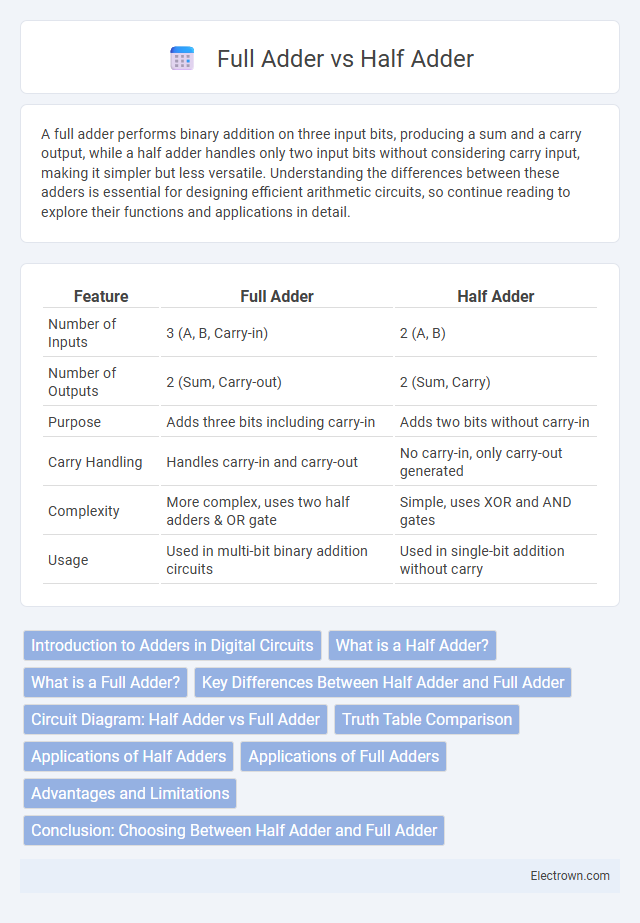A full adder performs binary addition on three input bits, producing a sum and a carry output, while a half adder handles only two input bits without considering carry input, making it simpler but less versatile. Understanding the differences between these adders is essential for designing efficient arithmetic circuits, so continue reading to explore their functions and applications in detail.
Table of Comparison
| Feature | Full Adder | Half Adder |
|---|---|---|
| Number of Inputs | 3 (A, B, Carry-in) | 2 (A, B) |
| Number of Outputs | 2 (Sum, Carry-out) | 2 (Sum, Carry) |
| Purpose | Adds three bits including carry-in | Adds two bits without carry-in |
| Carry Handling | Handles carry-in and carry-out | No carry-in, only carry-out generated |
| Complexity | More complex, uses two half adders & OR gate | Simple, uses XOR and AND gates |
| Usage | Used in multi-bit binary addition circuits | Used in single-bit addition without carry |
Introduction to Adders in Digital Circuits
Adders are fundamental components in digital circuits used for binary addition, with half adders performing the sum and carry operations for two single-bit inputs, while full adders extend this functionality by incorporating a carry-in input for multi-bit binary numbers. A half adder produces two outputs: sum and carry, but cannot handle carry input from previous stages, limiting its use to the least significant bit in multi-bit addition. Full adders are interconnected in ripple carry adders to enable the addition of binary numbers with arbitrary bit lengths, making them essential in arithmetic logic units (ALUs) and digital signal processors.
What is a Half Adder?
A Half Adder is a fundamental digital circuit that computes the sum of two single-bit binary numbers, producing a sum and a carry output. This circuit uses basic logic gates, typically an XOR gate for the sum and an AND gate for the carry, enabling simple arithmetic operations within digital systems. Understanding your half adder is essential for designing more complex circuits like full adders and binary adders in computing applications.
What is a Full Adder?
A Full Adder is a digital circuit that computes the sum of three binary inputs, typically two significant bits and an input carry from a previous addition. It produces two outputs: a sum bit and a carry-out bit, enabling multi-bit binary addition in sequential stages. Unlike a Half Adder, which adds only two binary digits without carry input, the Full Adder integrates carry propagation for more complex arithmetic operations in processors and digital systems.
Key Differences Between Half Adder and Full Adder
A half adder performs the addition of two single-bit binary numbers and produces a sum and carry output, while a full adder handles three inputs: two significant bits and a carry-in, generating a sum and carry-out. The full adder can be constructed by combining two half adders and an OR gate, enabling it to add binary numbers with carry-in, unlike the half adder which lacks carry-in functionality. Consequently, full adders are essential for multi-bit binary addition in arithmetic circuits, whereas half adders are primarily used for simpler, single-bit addition tasks.
Circuit Diagram: Half Adder vs Full Adder
The half adder circuit diagram consists of one XOR gate and one AND gate, enabling it to add two single-bit binary numbers producing a sum and carry output. The full adder circuit diagram incorporates two XOR gates, two AND gates, and one OR gate, allowing it to add three binary inputs, including the carry-in, to generate sum and carry-out outputs. This structural difference gives the full adder the capability to handle multi-bit binary addition through carry propagation, unlike the half adder.
Truth Table Comparison
A Full Adder processes three inputs--two significant bits and a carry-in--producing a sum and carry-out, unlike the Half Adder that handles only two inputs without carry-in consideration. The Full Adder truth table includes eight possible input combinations, whereas the Half Adder truth table consists of four. Understanding these differences helps you accurately design arithmetic circuits requiring carry propagation.
Applications of Half Adders
Half adders are primarily used in arithmetic circuits where basic binary addition of two single-bit numbers is required, such as in the initial stages of multi-bit adders. They find applications in digital systems like simple calculators, binary counters, and error detection circuits. Your understanding of half adders can enhance the design of efficient and compact combinational logic circuits.
Applications of Full Adders
Full adders play a critical role in arithmetic logic units (ALUs) and digital signal processing where multi-bit binary addition is required, such as in microprocessors and digital counters. They facilitate handling carry-in and carry-out signals, enabling cascading to build complex adders like ripple carry adders for multi-bit binary calculations. Full adders are also essential in designing arithmetic circuits including multipliers and subtractors in integrated circuit design.
Advantages and Limitations
A Full Adder offers the advantage of adding three binary inputs (including carry-in) which enables cascading for multi-bit addition, unlike a Half Adder that only sums two bits without carry input. Full Adders provide improved functionality in complex arithmetic circuits, but they require more logic gates, increasing circuit complexity and power consumption. Your choice depends on application needs--use Half Adders for simpler, low-resource designs, and Full Adders for accurate multi-bit binary addition with carry operations.
Conclusion: Choosing Between Half Adder and Full Adder
Choosing between a Half Adder and a Full Adder depends on your circuit complexity and input requirements. Half Adders handle the addition of two single-bit inputs, making them ideal for simple calculations without carry input. Full Adders support three inputs, including carry-in, which makes them essential for multi-bit binary addition and cascading in arithmetic logic units.
Full Adder vs Half Adder Infographic

 electrown.com
electrown.com